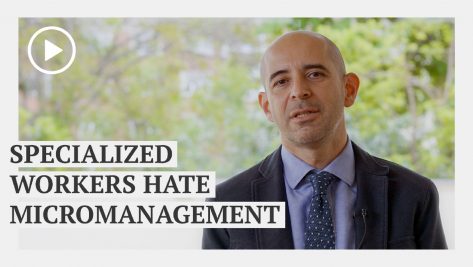Picking the executive to take the helm of the company is one of a board’s most important responsibilities. Focusing on the CEOs of the S&P 500 corporations as of 2005, our study is the first to look at past career experience and draw conclusions after tracking managerial performance for up to three years following their appointment. The results, which include companies from across all industries, show a negative relationship between prior job-specific experience and performance at the new firm, that is, a negative learning transfer. In other words, experienced CEOs pay a performance penalty insofar as they have to unlearn knowledge and skills to be effective in the new context.
Most previous studies have concluded that prior job-specific experience improved performance within the same context. In contrast, our findings are consistent with the few papers that found a negative relationship between prior CEO experience and performance at a new company.
Experience has a shelf life
Our findings contradict certain common assumptions of human capital theory, which suggests that the experience-based investments employees make in themselves enhance their job-related knowledge, skills, and abilities, thereby boosting their job performance. Instead we found that people tend to draw on experience from past events, which encourages the formation of “knowledge corridors,” making it difficult for them both to act differently in new contexts and to modify their decision-making templates. Both of these factors undermine performance. In other words, the cognitive mechanisms transferred from their previous job-specific experience debilitate their performance in the new position. Additionally, institutional rigidities can decrease the job performance of individuals with prior experience. Professionals who are well versed in the norms, culture, and routine of one organization may fail at another, due to the fixed assumptions they develop about how tasks should be done.
People often draw on experience from past events, leading to the formation of knowledge corridors that make it hard for them to act differently in changing contexts.
It is likewise worth recalling that experience has a shelf life: knowledge, skills, and abilities deteriorate over time if they are not reinforced. Thus, the longer it has been since an individual acquired a given set of knowledge, skills, and abilities, the less likely he or she will be to act on it, and the less likely this skill set will be to pose a cognitive liability and damage current performance. This line of research suggests that executives who take another position between two CEO jobs are less likely to be influenced by their prior CEO experience. In this regard, Morrison and Brantner have argued that learning in a new position is quicker when the immediately prior experience does not conflict with the knowledge, skills, and abilities that the new position requires.
Hiring to replicate past success?
Our findings contribute to the debate regarding the portability or context-specific nature of managerial human capital. The role of CEO requires radically different competencies from those needed for lower executive positions. Managing a firm’s board or its shareholders are both tasks that are performed more effectively by drawing on job-specific experience. In this regard, managerial tasks are generally considered to be highly interdependent, unstandardized, and contextual, as they vary depending on the functional area, management level, and organizational attributes of the particular context and cannot be easily adapted from one job to another.
However, Murphy and Zábojnik have argued that the relative importance given to general, as opposed to specific, managerial capital in the CEO job has risen over the last three decades, such that firms have increasingly come to rely on outside hiring. In this regard, we found that, at least at the CEO level, the transfer of job-specific skills across firms involves a performance penalty. This penalty is more severe when the executive moves directly from one CEO job to another and also when the two contexts are similar. Despite the surface similarities of firms of similar sizes and industries, there can also be significant operational and cultural differences.
A CEO’s functional background shapes his or her start at the new job, and the degree of change required by the new organization influences the entire process. Thus, another aspect to consider is that earlier strategies may not yield the same positive results. However, firms often overlook this fact, hiring CEOs with prior experience precisely to have them replicate their past success with a given task, such as selling a division or overseeing a merger or acquisition, only in a new organizational context and business environment.
New leadership role
Another key finding of our study, especially for selection and hiring committees, is that in the first three years post-succession, firms do not benefit from hiring CEOs with previous job-specific experience. In fact, our results were consistent with what practitioners have reported in this regard. For instance, when asked about the hazards of transitions, the expert Michael Watkins noted that the biggest trap was for leaders to believe they could continue to be successful by repeating the formulas they had successfully applied in the past. Too often, he said, “they fail to meet the adaptive challenge” and to recognize that their new leadership role requires a different set of skills and abilities. Similarly, Archie Norman, the former CEO of the supermarket chain Asda, in the UK, has said that while many CEOs are very successful in a given company at a given time, “the real test is if you take that genius and put him in a totally different situation to succeed again.” He therefore advises incoming CEOs to “be able to listen, able to understand” why the culture of the new firm might be totally different from that of the last.
Grooming internal leaders
When it comes to CEO searches, one common criticism is that search firms often focus on the most obvious candidates or those whose current positions match the one they are seeking to fill, rather than risk bringing in promising lower-level executives. As a result, these firms may consider only CEOs at other firms, ignoring high-potential chief operating offers (COOs) or executive vice presidents (EVPs) from the companies themselves.
Our analysis shows that this approach to the selection process may not be beneficial to organizations. Boards should thus think twice before hiring CEOs from other companies to run their own and give greater consideration to internal successions. Additionally, the teams responsible for hiring CEOs should have them take an interim position at the company for at least a year before stepping up to the helm. This will allow them to acquire company-specific human and social capital and, more importantly, give them time to unlearn the knowledge and skills associated with their old job.
CEOs are often hired to replicate their past success with a given task, only in a new organizational context and business environment.
One of the biggest problems facing leaders who change jobs is that they assume that similar processes between the two positions signify similar cultures and thus fail to adapt to their new company’s ways of doing things. It is important for incoming CEOs to make a psychological break between their old and new jobs and to take a systematic approach to understanding the new company’s employees, products, structure, culture, and politics. However, companies themselves should also facilitate this transition, paying more attention to the new leader’s acculturation, an area that is hard to quantify and, thus, often neglected. Specifically, new companies should evaluate and be frank with the candidate about their culture and the behavior they expect. At the same time, they should implement a gradual integration plan, involving training for executives on how to move to the new organization, diagnose it, and align their strategy and skills.
This analysis focused on large firms. Future research should seek to determine whether the findings can be generalized to the managers of small and medium-sized firms as well, where the relationship between CEO experience and job performance may be more pronounced, as CEOs are less constrained by organizational inertia.
© IE Insights.











